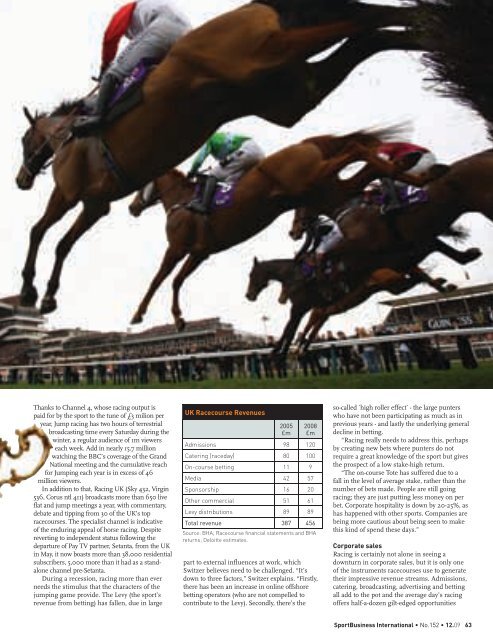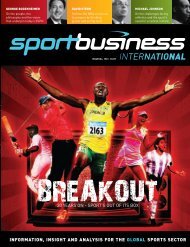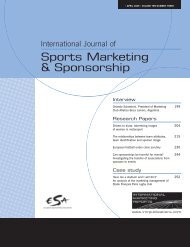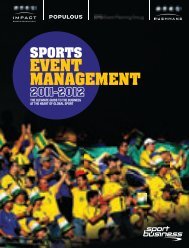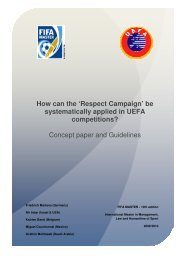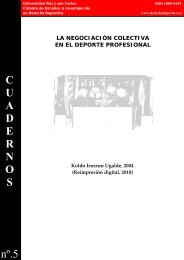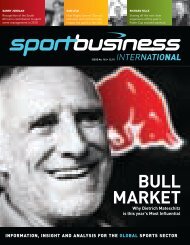01 cover sbi 152.indd - FIFA/CIES International University Network
01 cover sbi 152.indd - FIFA/CIES International University Network
01 cover sbi 152.indd - FIFA/CIES International University Network
Create successful ePaper yourself
Turn your PDF publications into a flip-book with our unique Google optimized e-Paper software.
Thanks to Channel 4, whose racing output is<br />
paid for by the sport to the tune of £3 milion per<br />
year, Jump racing has two hours of terrestrial<br />
broadcasting time every Saturday during the<br />
winter, a regular audience of 1m viewers<br />
each week. Add in nearly 15.7 million<br />
watching the BBC’s <strong>cover</strong>age of the Grand<br />
National meeting and the cumulative reach<br />
for Jumping each year is in excess of 46<br />
million viewers.<br />
In addition to that, Racing UK (Sky 432, Virgin<br />
536, Corus ntl 411) broadcasts more than 650 live<br />
flat and jump meetings a year, with commentary,<br />
debate and tipping from 30 of the UK’s top<br />
racecourses. The specialist channel is indicative<br />
of the enduring appeal of horse racing. Despite<br />
reverting to independent status following the<br />
departure of Pay TV partner, Setanta, from the UK<br />
in May, it now boasts more than 38,000 residential<br />
subscribers, 5,000 more than it had as a standalone<br />
channel pre-Setanta.<br />
During a recession, racing more than ever<br />
needs the stimulus that the characters of the<br />
jumping game provide. The Levy (the sport’s<br />
revenue from betting) has fallen, due in large<br />
UK Racecourse Revenues<br />
2005<br />
£m<br />
2008<br />
£m<br />
Admissions 98 120<br />
Catering (raceday) 80 100<br />
On-course betting 11 9<br />
Media 42 57<br />
Sponsorship 16 20<br />
Other commercial 51 61<br />
Levy distributions 89 89<br />
Total revenue 387 456<br />
Source: BHA; Racecourse financial statements and BHA<br />
returns; Deloitte estimates.<br />
part to external influences at work, which<br />
Switzer believes need to be challenged. “It’s<br />
down to three factors,” Switzer explains. “Firstly,<br />
there has been an increase in online offshore<br />
betting operators (who are not compelled to<br />
contribute to the Levy). Secondly, there’s the<br />
so-called `high roller effect` - the large punters<br />
who have not been participating as much as in<br />
previous years - and lastly the underlying general<br />
decline in betting.<br />
“Racing really needs to address this, perhaps<br />
by creating new bets where punters do not<br />
require a great knowledge of the sport but gives<br />
the prospect of a low stake-high return.<br />
“The on-course Tote has suffered due to a<br />
fall in the level of average stake, rather than the<br />
number of bets made. People are still going<br />
racing; they are just putting less money on per<br />
bet. Corporate hospitality is down by 20-25%, as<br />
has happened with other sports. Companies are<br />
being more cautious about being seen to make<br />
this kind of spend these days.”<br />
Corporate sales<br />
Racing is certainly not alone in seeing a<br />
downturn in corporate sales, but it is only one<br />
of the instruments racecourses use to generate<br />
their impressive revenue streams. Admissions,<br />
catering, broadcasting, advertising and betting<br />
all add to the pot and the average day’s racing<br />
offers half-a-dozen gilt-edged opportunities<br />
SportBusiness <strong>International</strong> • No.152 • 12.09 63


